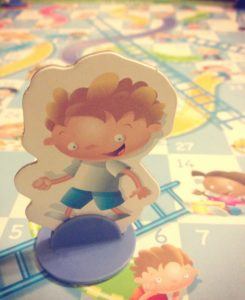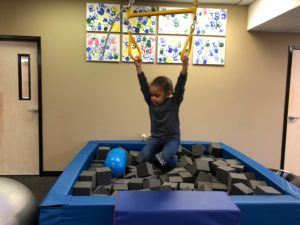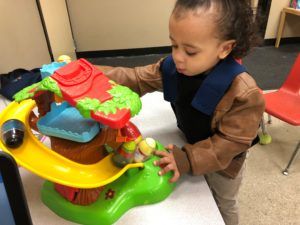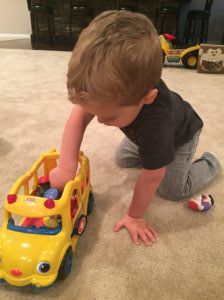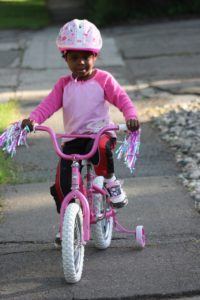Speech and Language
- Speech Sound Grab Bag: Fill a medium sized gift bag or tote bag with small objects/pictures that begin (or end) with the targeted sound. Have your child take out each object and practice saying that word and talk about what he/she found. Your child will love digging into the bag and feeling the objects inside to see what is hidden inside!
For example: /k/ sound objects could include keys, (pretend) cookie, cup, kit-kat bar, rubber duck (quack-quack AND final /k/ in duck), book, ketchup packet, small stuffed animal cat, cork, can of soda or coke, small cake candle, pretend slice of cake, napkin, plastic/toy fork, packet of hot cocoa)
- Flashlight Game: Get out a flashlight and place pictures or objects that target the speech sound and place them inside child’s bedroom or other room, turn off the lights and have the child shine the light around the room to “find” the objects. Your child will love playing with the flashlight and searching for the cards or objects.

- Memory match up: Make small cards (with photos or clipart) with targeted speech sound so that you and your child
 can play the memory matching game. Place all cards face down and have your child see if they can remember where the cards are and whoever has the most matches wins the game.
can play the memory matching game. Place all cards face down and have your child see if they can remember where the cards are and whoever has the most matches wins the game. - Book Reading: Choose a book from your local library that targets the speech sound, read with your child (or maybe they can read to you!)
- Board Games: Incorporate your child’s favorite board game and upon taking a turn, have your child say a word 2-3 times targeting that speech sound (see if your child’s speech pathologist can give you a practice word list or photocopied pics). Game suggestions: Candyland, Chutes and Ladders, UNO, Guess Who?)

- Sound guessing game: Practice “sound discrimination” at
- home by hiding your mouth with a piece of construction paper. Say a word that begins with the targeted sound (i.e. “seat”) and ask the child, “Did I say the /s/ or the /sh/ sound?” Choose words that rhyme but begin with the targeted speech sounds. (i.e. cake/take)
- Build a “road” for cars: line picture cards for targeted speech sound face down, have your child help you build a “road” and turn over the cards as the car “drives’ along the road, saying the sound as the cards are turned over.
- B-I-N-G-O: Use a bingo board and markers/chips that contain pictures of the targeted speech sound. This is a great way to include multiple family members!
- Coloring: Use coloring sheets that include popular cartoon characters or scenes with targeted speech sounds. Sit with your child and have the child say one of the targeted words before receiving a crayon or marker to color a certain part of the coloring sheet. This way they are coloring as they are practicing the sounds.
- Baking or Crafting: Have your child bake or put together a craft and target that sound during the activity. Examples of targeted words: cookies, cake, rolling pin, pat-pat-pat, push, cookie cutters, shapes, cook, bake, hot, mix, stir, egg, break, roll, pull, glue, stick/sticky, cut, in, out.
By the time a toddler has a vocabulary of at least 30-40 words, they begin to put words together into 2-word phrases (the child must be USING the 30-40 words in spontaneous speech to comment/request/label, not just imitating). The general “rule of thumb” is that at age one, children use only ONE word to communicate, then at age two, they use TWO words, by age three, they are using THREE or more words in sentences (requesting/commenting/asking & answering questions). I find myself using the following strategies right now with my 24-month-old and thought I’d share some ways to help increase the 2-word phrases in your toddler’s vocabulary.
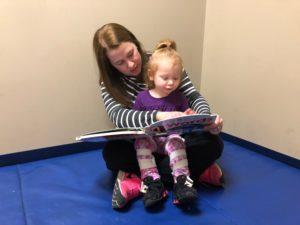
- One simple way is to build phrases using words your child already has in their vocab.: Does your child have some functional words associated with mealtime, bedtime, playtime etc.??? Try adding MORE and PLEASE to those words. For example, “more juice”, “help please”, “out please”. “more crackers”, “up please”.
- Incorporate greetings to build phrases: “Hi daddy”. “bye-bye nana”

- Model phrases throughout your daily routines, commenting on what is happening or what your child is doing, “night-night baby”, “go out”, “want up?”, “purple ball”, the more these phrases are modeled, the greater the chance your child will begin to imitate!
- Incorporate “automatic” phrases as well: For example, “I did it”, “this one”, “that one”, “my turn”, “let’s go”, “no mine”
- If you notice that your child isn’t quite catching on to 2-word phrase imitation, begin by repeating single words in a string, for example, “go-go-go!”, “up-up-up”, “night-night” to see how they respond.
If you have concerns about your child’s development, visit our webpage at https://www.abcpediatrictherapy.com for more information.
Written by: Christina Sanford, MA, CCC-SLP
Read More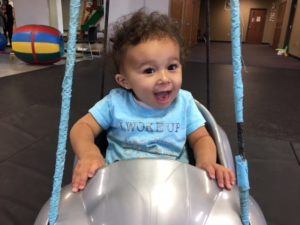
| By 6 Months | · Does not laugh or squeal · Does not look toward new sounds · No eye contact with parent |
| By 9 Months | · Has limited or no babbling |
| By 12 Months | · Does not point to objects · Does not use gestures such as waving |
| By 15 Months | · Does not have “first” word · Does not respond to own name |
| By 18 Months
| · Does not use at least 6-10 words consistently · No imitative skills (gestures or verbal) |
| By 20 Months | · Does not follow simple directions |
| By 24 Months | · Has a vocabulary of less than 50 words · Has decreased social interactions · Not combining words |
| By 36 Months | · Strangers have difficulty understanding what the child is saying · Short utterances only; limited conversational skills |
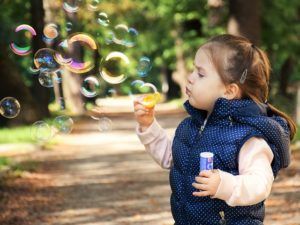
If you have questions about your child’s development, visit our website at https://www.abcpediatrictherapy.com
Written by: Christina Sanford, MA, CCC-SLP
Read MoreASAP, YMCA, RSVP. Acronyms are all around us, permeating our lives and activities. Sometimes we truncate words just for the heck of it, “kay” instead of “okay” or “app” instead of application. Then there’s the world of healthcare and medicine, and suddenly everything is a jumbled mess of alphabet soup. It’s hard to keep track of what all the acronyms and abbreviations stand for, so today’s focus is on AAC. It stands for Augmentative and Alternative Communication.
That’s a lot of words and letters to type; healthcare professions like the quick version “AAC” much better. As parents, it’s a lot scarier to hear another clump of letters without really understanding what it means. AAC is basically a way for individuals to get help (augment) or replace (alternative) communicatio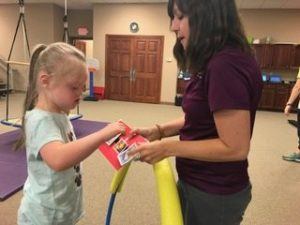 n. AAC can come in a high tech form or a low tech form.
n. AAC can come in a high tech form or a low tech form.
Low tech AAC is anything that doesn’t get programmed with a digital voice, message, or screen. There is a low tech form of AAC called Picture Exchange Communication System (sorry, it’s another acronym: PECS), which is all about requesting and then commenting using special pictures. Other low tech forms of AAC could be a book full of pictures people can point to for requesting or even a book of common people or activities in their day-to-day life. High tech AAC (think Stephen Hawkings) is about ease of access, comfort of use, and typically is used by communicators with a little more ability to understand the complexity of a more complicated system, although preschoolers to the elderly can use high or low tech AAC.
High tech AAC can be as simple as one giant, clicking button, called a switch. Some switches have 1 big button, others have a few smaller buttons. Each button holds a single, recorded message. When the communicator bumps or hits the switch, the message plays. AAC can also be as complicated as an IPad application or specialized, portable machine that’s only job is to talk. These higher tech devices come with programmed software from screen layouts of 4 to 50 full of vocabularies, subjects, word prediction, keyboards, games, search functions, access to the internet for social networking, and the list of possibilities goes on.
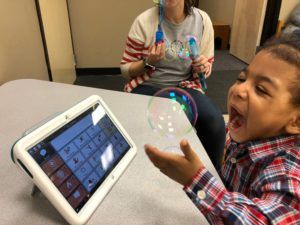
Now that we’ve had a quick background, the initial fear of the unknown should be fading…and all the questions are forming. The first thing to realize is that AAC can either augment language where it boosts, helps, and lifts a speaker’s verbal communication or it can be an alternative for them, or the third option: AAC can do both augment and be an alternative. Simply because a kiddo needs AAC doesn’t mean they don’t need their voice. Having goals in therapy to address AAC doesn’t mean your child isn’t learning to use their verbal words. In no way does it mean a child’s verbal and expressive language skills will fade, stop, or never grow. In fact, the truth is that AAC does the opposite. It makes verbal language explode. AAC gives children with a variety of diagnoses, disorders, delays, and deficits the ability to communicate with adults, teachers, and peers who may not have understood them before. It teaches children to actively seek out communication partners, to make requests, and to share their thoughts and ideas in a way that without the AAC would likely not have happened. AAC gives children opportunities. AAC gives children confidence. AAC gives children power. AAC gives children models, repetitions, and examples of more words than they would have had access to on their own, and soon, the children have heard the word enough from the AAC, that they can start verbalizing it on their own. AAC is fully customizable, modifiable, and portable. It goes where your child goes, can be used as your individual child needs, and there is no limit to the potential for their language. AAC is kind of like pixie dust…a little sprinkle can transport a child to Never Neverland: a new world of wishes, wonder, and words that they’ve never, never seen before…and you get to go along for the ride.
Read More Skip to content
Skip to content
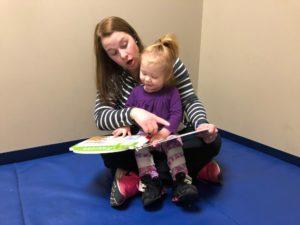
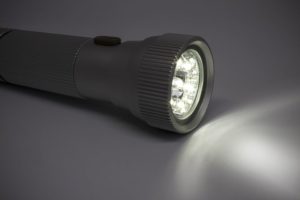
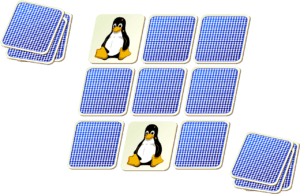 can play the memory matching game. Place all cards face down and have your child see if they can remember where the cards are and whoever has the most matches wins the game.
can play the memory matching game. Place all cards face down and have your child see if they can remember where the cards are and whoever has the most matches wins the game.